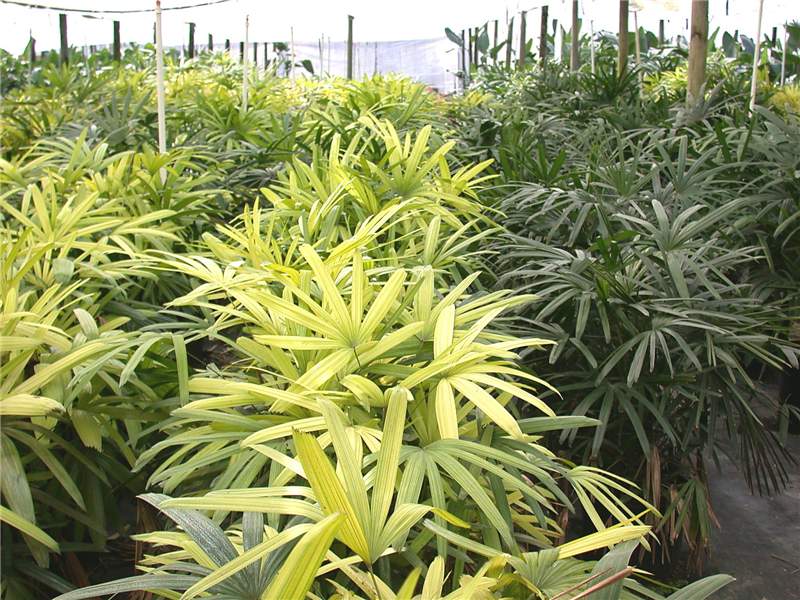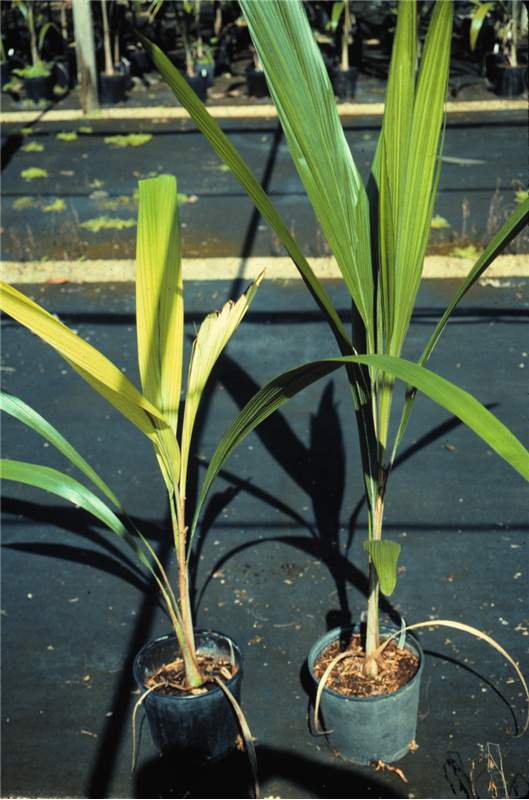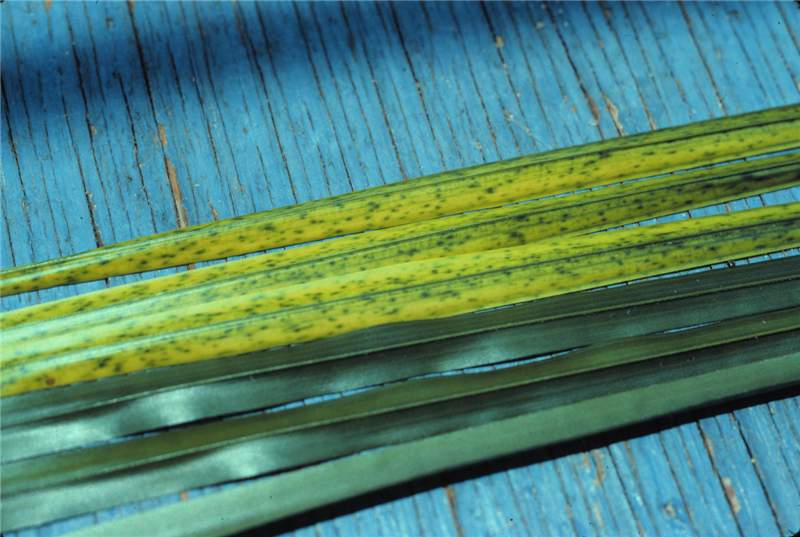Iron Deficiency
|
Figure 1. Iron-deficient Rhapis excelsa on left with healthy palms on right. Photo by T.K. Broschat
|
|
Figure 2. Severe Fe deficiency on Syagrus romanzoffiana seedling (left). Normal palm on right for comparision. Photo by T.K. Broschat
|
|
Figure 3. Severe Fe deficiency on Syagrus romanzoffiana seedling (left). Normal palm on right for comparision. Photo by T.K. Broschat
|
|
Figure 4. Mild Fe deficiency symptoms on leaflets of new leaves (two upper leaflets) and symptom-free older leaves (two lower leaflets). Photo by T.K. Broschat
|
Symptoms
Iron (Fe) deficiency appears as interveinal or uniform chlorosischlorosis:
a loss of chlorophyll resulting in white, yellow, or orange leaf color
of the newest leaves (Figs. 1 and 2). Older leaves remain green. In severely Fe-deficient palms, new leaflets may have necroticnecrotic:
see necrosis
tips, growth will be stunted, and the meristemmeristem:
the growing region of a plant, a special area of undifferentiated cells wherein new cells and organs are developed
may eventually die (Fig. 3). Early symptoms in Syagrus romanzoffiana, Rhapis spp., and some Licuala spp. appear as chloroticchlorotic:
see chlorosis
new leaves covered with green spots 2 to 4 mm in diameter (Fig. 4).
May be confused with
Royal palm bug damage is very similar in royal palms, as both result in a general chlorosischlorosis:
a loss of chlorophyll resulting in white, yellow, or orange leaf color
of the spear and youngest leaf. Iron deficiency chlorosischlorosis:
a loss of chlorophyll resulting in white, yellow, or orange leaf color
will generally remain on the youngest leaf as it matures, while the yellowing caused by royal palm bug is transient and will eventually turn into leafletleaflet:
divisions of pinnate leaves
necrosis and frizzling. Iron deficiency symptoms are commonly expressed in palms suffering from root suffocation, excesses of other micronutrients such as manganese, and root rot diseases, although in these cases, the iron deficiency is not the primary problem and will usually disappear if these other problems are corrected.
Cause
Iron deficiency is usually not caused by a lack of Fe in the soil, but rather by poor soil aeration or by planting palms too deeply. Both factors reduce root respiration and therefore active uptake of Fe. Root injury from root rot diseases will similarly be expressed above ground as Fe deficiency, since the root surface area available for interception and uptake of Fe will be greatly reduced in root rotted palms. High soil pH is the most common cause of Fe deficiency in broadleaf trees and shrubs, but in palms it is less likely to cause Fe deficiencies. Excessive uptake of other nutrient ions such as ammonium, phosphate, manganese, zinc, copper, and other heavy metals often results in Fe deficiency symptoms being expressed.
Occurrence
Fe deficiency is much more common in container production than in landscape or field nursery situations. Palms are typically slow-growing and may stay in a container for a year or longer. The organic components of container substrates tend to degrade into fine particles over time, reducing soil aeration in the process. Most palm species are susceptible to Fe deficiency under conditions of poor soil aeration, but Wodyetia bifurcata is particularly prone to Fe deficiency induced by high soil pH.
Additional comments
Leaf Fe concentrations often show little or no relation to Fe chlorosischlorosis:
a loss of chlorophyll resulting in white, yellow, or orange leaf color
severity and are therefore not a reliable indicator of plant Fe status.






